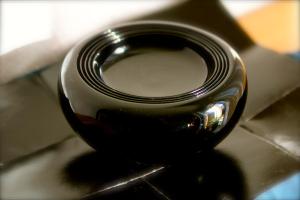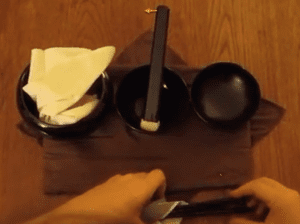
Recently, we held a three-day retreat focussed on Dōgen’s “The Dharma for Taking Food” (Japanese, “Fushukuhanpō”). (1) In this fascicle, Dōgen unpacks the meaning and details of the Sōtō Zen method for eating with bowls that hold just enough, or “oryoki” (pictured above and in the video below).
This post touches on a few points of interest for me in the Sōtō Zen art of receiving a meal. You will not learn, of course, how to eat this way from reading this post. For that, it’s best to personally study with someone who gets this dharma. But if you want to get a taste of it or refresh your skills, a good resource is the Austin Zen Center’s “Learn About Oryoki” page – click.
Ok. Back to Dōgen and “The Dharma for Taking Food.” The first point, to repeat, is that in Dōgen Zen, receiving a meal is an art. Like any art, there’s a flow to doing it. It can’t really be taught, although it does flow hand-to-hand. In my own Sōtō training, I had the great opportunity to observe Katagiri Rōshi flowing artfully through a thousand or so meals with oryoki bowls. The old boy really got this dharma! As for me, though, I’ve come to most appreciate the significance of the wiping cloth, or Wiping Cloth Sensei, as I think of them. More on that later.
Now, in contrast to how this style of eating is often framed in our contemporary Zen scene, Dōgen uses the word mindful just once in his “The Dharma for Taking Food,” saying:
“At this time the monks gassho and in a loud voice mindfully chant….”
And this one-time usage isn’t about chewing the rice in a pretentious, mindful masquerade, but chanting loudly.
Mindfulness is a factor in the art of receiving a meal, but there are a lot of simpler ways to eat mindfully, if that’s what you’re about. So no need for this elaborate practice. As for “The Dharma for Taking Food,” in addition to mindfulness, there are other factors too, like interdependence, reverence, gratitude, and wholeheartedness. But Dōgen emphasized something other than these as well.
Emptiness Comes Specifically
Dōgen begins the “The Dharma for Taking Food” with a passage from the Vimalakirti Sutra: “If you can remain the same with food, all dharmas also remain the same; if all dharmas are the same, then also with food you will remain the same.”
For Dōgen, practicing emptiness, i.e., the equality of all dharmas, is the most important aspect of this way of receiving a meal. The imbedded kōan might be, “When all things are empty, what do you eat? How do you eat? Who eats?”
Dōgen then expanded his key point – dharmas, essential nature, and awakening are all just the food before us now and the food before us now, is exactly dharma, essential nature, and awakening. That is the vital spirit of receiving a meal offering. Given essential equality, Dōgen then goes on to give detailed directions for the steps in the receiving the meal from opening to closing the wrapped bowls, with hundreds of specific directions. For example:
“With your right hand holding the edge of the place mat that is toward you so that it is over the bowls, lift the bowls with the left hand and place them down on the left side of the place mat.”
“During this ceremony, remain in gassho and do not talk, laugh, nod your head, or move around, but just sit silently.”
“After bowing in front of Manjushri, the anja then stands in shashu and announces the meal. The words must be announced clearly with the names correct. If there is any discrepancy the dharma of receiving food is not complete, and it must be announced again.”
If Everything Is Equal, Why Be So Precise?
A while ago, I heard a story second-hand that responds to this question very well. Ejo McMullen Osho, the teacher of the Buddha Eye Temple in Eugene, Oregon, told a story from his training in Japan. He was preparing for a big ceremony with a senior monk, and asked the monk to explain why it was that the green tea was always placed to the left and sweet hot water was always placed to the right of the main figure on the altar. “If I understood why it was, I think I could remember which goes where.”
This is certainly a problem for me too. Even after many years as a Zen priest, I have to consult the ceremony manual for this detail every time.
The monk is reported to have said, “Because it completely doesn’t matter which goes on the right and which goes on the left, we always place the green tea on the left and the sweet hot water on the right.”
That is the spirit of giving ourselves to the details that is emphasized Sōtō Zen.
Seventy-four Do Nots
In addition to the detailed choreography for the art of oryoki eating, Dōgen also gave instructions about what not to do. The text, in fact, contains seventy-four Do Not’s. For example:
Do not pour the leftover water on the floor.
Do not pour the water on the robe sleeves of the server.
Do not wash your hands in the [bowl-washing] water.
Do not poke your hips or elbows over into your neighbors.
Do not grab the utensils from the server’s hands and pick out whatever you want.
Do not scratch your head and let dandruff fall into your bowls.
Do not spit it out into the bowls or elsewhere.
Usually, it seems to me, we only make rules when needed. Dōgen must have been responding to monks doing exactly the things – poking, spitting, dandruff falling into bowls, etc. – that he proscribes. What wild and wooly group of mountain monks!
Wiping Cloth Sensei
Finally, all of the players in the oryoki team – each bowl, the lapkin, spoon, chopsticks, spatula (or setsu), and the utensil holder, as well as the servers and the food – all have a role to play and do so in a consistently upright manner, i.e., very precisely prescribed. All but Wiping Cloth Sensei, that is.
The photo below is the only image that I could find in all the vast internet of Wiping Cloth Sensei (white cloth on left). Wiping Cloth Sensei is totally underrepresented and ignored, despite their vital function of drying the bowls.
The setsu (spatula), by the way, is a bit crooked and should really point straightly, so I added the arrow. I just couldn’t help myself.
But back to Wiping Cloth Sensei. The only rule for Wiping Cloth Sensei in all of Dōgen’s work is to stay in the bowl (see below). Just stay in the bowl.
Within all this precise and carefully choreographic flowing – “Dharma for Taking Food” – Wiping Cloth Sensei alone gets to be a rather wadded mess. The pictured wiping cloth, by the way, is really too neat. That Wiping Cloth Sensei gets to be a mess is extremely important. Whatever you do, don’t try to organize Wiping Cloth Sensei! Let the rumpled, be the rumpled! If you try to straighten out Wiping Cloth Sensei, you will kill the spirit of the oryoki meal. And someone could get hurt, like in our last oryoki meal of the retreat when a student tried too hard to pull the wrinkles out of Wiping Cloth Sensei, who naturally resisted such treatment, and the student wound up tearing their hem clean off.
Wiping Cloth Sensei plays the vital role of not looking all that good. Keep that in mind.

(1) Dogen’s Pure Standards for the Zen Community, trs., Leighton and Okumura, p. 83 – 108.

Dōshō Port began practicing Zen in 1977 and now co-teaches at the with his wife, Tetsugan Zummach Ōshō. Dōshō also teaches with the Vine of Obstacles: Online Support for Zen Training, an internet-based Zen community. Dōshō received dharma transmission from Dainin Katagiri Rōshi and inka shōmei from James Myōun Ford Rōshi in the Harada-Yasutani lineage. He is the author of Keep Me In Your Heart a While: The Haunting Zen of Dainin Katagiri.











